A Botanist’s Advent Calendar
An advent calendar inspired by nature to enchant and spoil us, like a warm embrace by the fireplace.
An advent calendar fit for a botanist
An advent calendar inspired by nature to enchant and spoil us, like a warm embrace by the fireplace.
Materials required for our plant-based advent calendar
An advent calendar made from salvaged materials. Small budget, but plenty of heart. The idea is to make do with what you have to hand. Simply find alternatives for anything you don’t have. Find, recover, recycle.
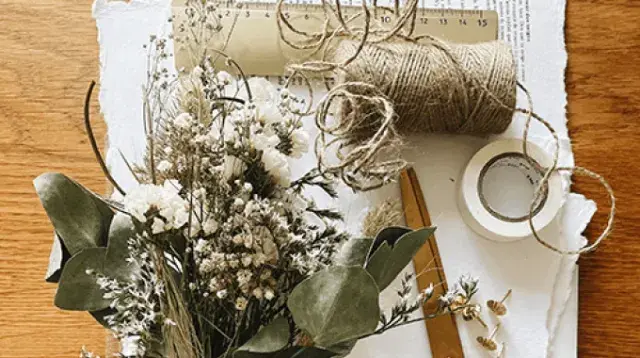
A wooden board for the base. We used a 90 cm x 110 cm board from an old activity. If you don’t have anything similar, you can always ask for some old scrap wood at a DIY shop. If your wood is too light, you can naturally stain it using coffee or walnut wood stain to darken it slightly, or a lot, as enthusiastically as you like!
Plants. Small bouquets of dried flowers put aside throughout the year. Some garden leaves. Nature gives us so many treasures, let’s make the most of them and put the spotlight on them this festive season
Recycled paper 21 cm x 29.7 cm. We used cotton paper with untidy edges, adding some home-made charm
String, nails (we used gold pins), sticky tape (we used clear white), a pencil, a black pen, a ruler and a pair of scissors
A Christmas story or similar alternatives. We’ll tell you about our favourites later on.
At the heart of nature...
To make our botanist’s advent calendar, we’re going to need 24 plant specimens.
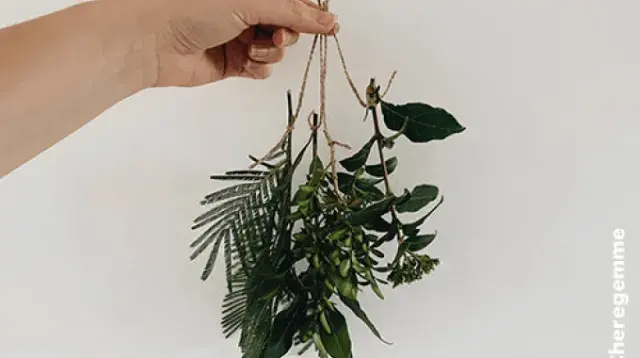
You can put together your advent calendar using beautiful pressed flowers, but we chose to dry them upside down, in the warm and dark, to keep their volume and voluptuousness.
Don’t be afraid to play around with different contrasts, colours, volumes and textures. Make sure to use seasonal plants and those that have dried out with the natural passing of the seasons.
Wild teasel, linseed, curry plant, olive trees, oats, honesty, baby’s breath, boxwood, Canary grass, sea lavender, eucalyptus, scotch broom, hare’s tail grass, yarrow, guelder-rose, dusty miller, sea lavender, butcher's-broom, bay laurel, wild carrot, poppy, tufted hairgrass...
... and memorable moments
Every day, in the countdown to Christmas, you’ll be able to share some wonderful memorable moments.
Behind each botanist card, you can add a special message to enjoy. Perhaps a passage from a favourite Christmas tale to experience a little of that magic festive spirit every morning, or why not write your own short story, developing as each day goes by. You could even include some IOU gifts, both to share and receive, as well as suggested activities, workshops and special evenings out. Wonderful moments to share with our families, whether through a kind word or a photo, so we never lose that festive sparkle.
Or perhaps you’d prefer to include a special mixture of everything?
A little Christmas tale on day one, a ‘voucher for a cinema trip’ on day two, a lovely kind word from Granny on day three, another Christmas tale on day four, a ‘pancake-night promise’ for day five, a photo of a cousin who lives far away on day six, and so on... turning the unbearably long wait for Christmas into some truly special and unforgettable moments.
How to make our plant-based advent calendar

To begin, separate some A4 sheets of recycled paper (21 cm x 10 cm) into 3 identically-sized cards. As we’ve gone for cotton paper with untidy edges, the idea is to tear (rather than cut out) the cards that will make our botanist’s advent calendar...
You’ll need 24 cards in total. These cards will make up our botanist’s advent calendar and the 24 days of December leading up to Christmas Day.
Write your message on the back of each card. Perhaps a part of a Christmas tale printed and stuck on, a short handwritten story, an ‘IOU voucher’ for something special, some kind words or a family photo. The advent calendar can come together however you like.
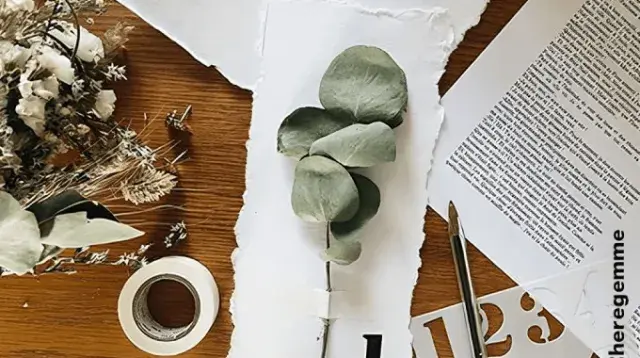
On the other side, simply tape down one of the plants you’ve previously dried out. They’ll need to be cut so that each plant or bouquet fits on a card, then give each one a number from 1 to 24.
If you’ve decided to go for sections of a Christmas story on the back, make sure you number the cards in the right order of your story. You’d be annoyed if Day 1 gave away the ending!
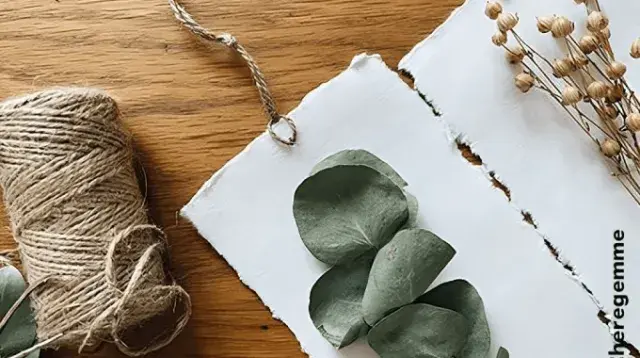
Make a small hole at the top of each card in the middle and thread some string through so it can be hung up.
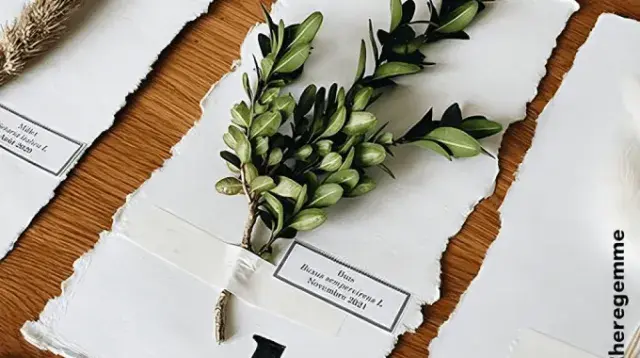
To finish off the front of each card and learn while having fun, write down the name of each plant on its card. Just like a traditional herbarium, you can note down each plant’s common name, its scientific name, as well as its harvest date.
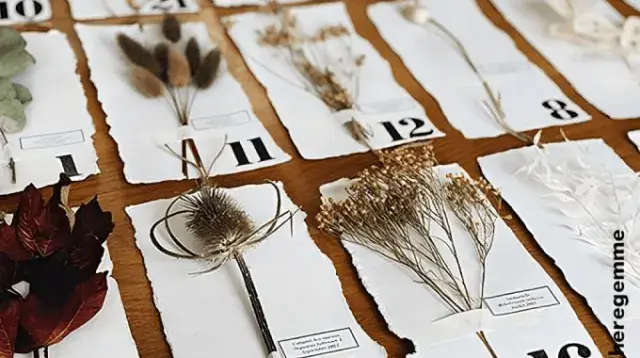
Your beautiful herbarium is taking shape...
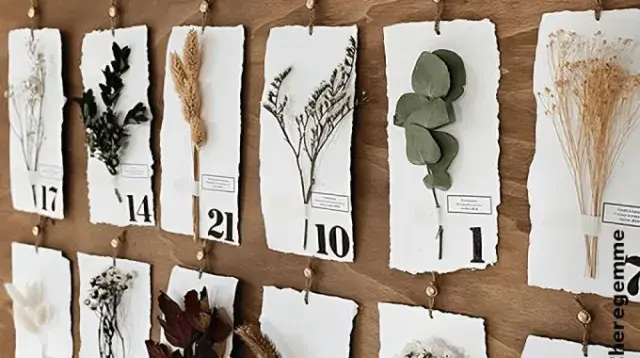
Space the nails or pins out regularly around your wooden base (90 cm x 110 cm) for hanging each of your advent calendar cards. Make sure to shuffle each of the cards before hanging them up, so they’re in a random order on your board.
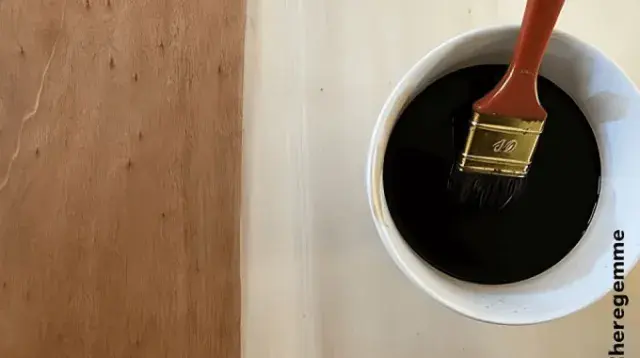
Our wooden base was initially too light, so we tinted it naturally with some diluted walnut wood stain (1 part stain to 2 parts water). For lighter shades, you can even use coffee.
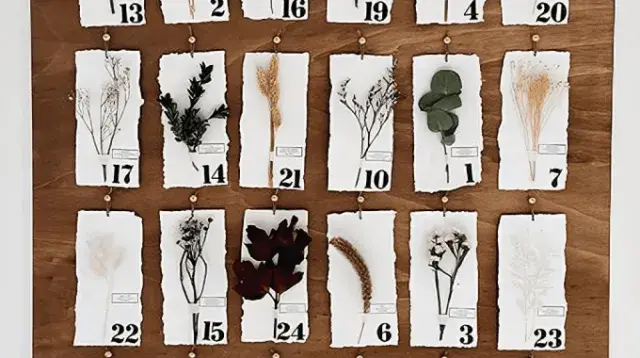
Your botanist’s advent calendar is ready. Now all you have to do is wait for the first of December for your plant-based advent calendar to start telling its many wonderful stories. For now, you can enjoy how it brightens up your living room or bedroom, bringing nature into your home.
Merry Christmas!
